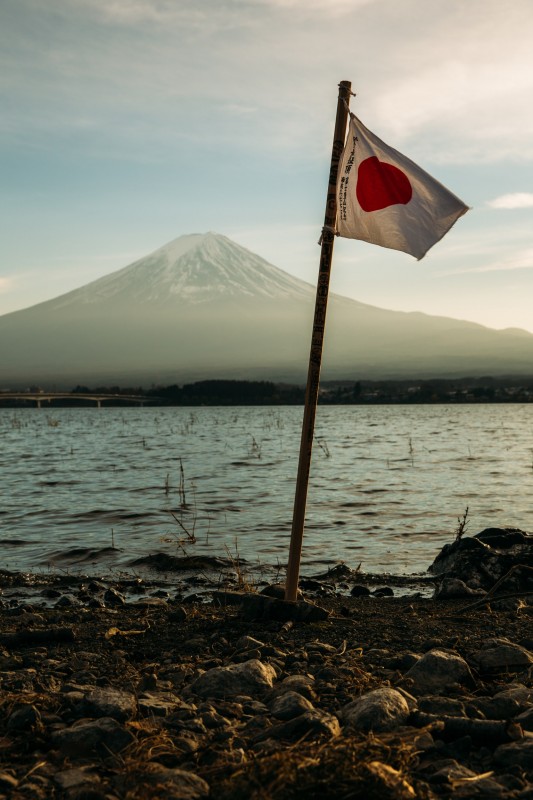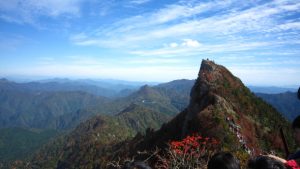
Photo by Stephen Diaz
Green Shinto is very much in favour of the recent trend towards spiritual tourism, whereby travel overseas is coupled with a desire to enhance spirituality through transforming experiences. Ancient pilgrimage routes are one way in which this can be done, and Japan is particularly rich in trails which lead to numinous power spots. Another way of furthering spirituality is to ascend holy mountains noted for centuries of worship and accumulated energy. The climb upwards literally raises the pilgrim above the mundane and into a purer realm. Again Japan can boast more than its fair share of sacred mountains, and the article below by Green Shinto reader, Sally Keys, highlights just three of them. (For other Green Shinto articles on the subject, see the bottom of the page.)
Experience Spiritual Awakening Among Japan’s Mountains
by Sally Keys
70% of Japan’s countryside is mountainous and this forms an important part of its culture and heritage. Just as Buddhism emerged from the Himalayas and Zeus lived on Mount Olympus, the Japanese mountains too are a source of spirituality and mythology. Spiritual tours operate close to nature and away from tourist hotspots. This is to allow contemplation of the true profundity of existence. Here are some of Japan’s most spiritual mountains and why you should visit.
Mt. Fuji
Perhaps the most recognizable symbol of Japan, Mt. Fuji is the tallest mountain in the country at over 1200ft. Fuji is a mysterious mountain, viewable from many areas of Japan, while occasionally disappearing behind clouds for several days at a time.
A symbol of both protection and violent anger, it is inspiration to a vast array of legends and artworks. Some 300,000 people climb the mountain each year, but its sheer size means that it is easy to become lost and alone here. Photographs cannot do justice to the feeling of seeing Mt. Fuji in person. Its terrifying power can induce states of awe and wonder, helping you to reconnect with nature.

Courtesy psy.ritsumei
Mt. Atago
At just over 3000ft, Kyoto’s Mt. Atago cannot compete with Fuji for height, but it is a magnificent mountain nonetheless. For centuries it has served as a place of pilgrimage and prayer, offering protection from fire. A shrine to the god of fire, Kagutsuchi, sits within Mt. Atago. A study by the University of Alabama revealed that being near fire causes blood pressure to drop and so can create relaxed states conducive to meditation and spiritual awakening.
This is probably due to fire being an ancient discovery that stopped the human race from becoming extinct and allowed us to flourish. As a result, it is evolutionarily engrained in us to become relaxed whenever we are around fire.

Courtesy Jetcolors
Mt. Ishizuchi
Towering at 6,500ft, Mt. Ishizuchi in Shikoku is another sacred mountain, popular with spiritual travellers. It is a popular place of ritual among ascetics, who abstain from sensual pleasures in the pursuit of spiritual growth. Climbing season starts on July 1st, but October is a popular time to put on your hiking boots and experience the incredible beauty of the fallen autumn leaves.
The mountains of Japan are numerous and vast. Hiking among their foothills will help you to understand the emotions of the Ancients, who worshipped these mountains and viewed them as the abodes of gods. Spend some time here to awaken that spirituality deep within you.

A week at Koya-san was one of the most spiritual times of my life. Yet I could speak little Japanese at the time and was disappointed that there was not a special place to write The Heart Sutra at the university, other than a room with desks and copying through glass. I had been studying calligraphy for but a short time. I intended to stay three days but extended my stay and only found out at the end that usually three days was the maximum allowed. The Head Monk allowed me to write The Heart Sutra in their main shrine room each day. Ahead of me was a beautiful Buddha and behind me, way back, was a ping-pong table. My “practice” was haphazard, but each morning I would attend the “fire ceremony”. Overall, it was an amazing experience.
Thanks for writing in, Rona. Koya-san is indeed a remarkable place, and I think anyone who has been to the cemetery in the early morning knows the strong sense of atmosphere that is palpable there. Your experience with the Heart Sutra caught my attention because of the ping-pong table. I’m fond of playing, but opportunities are few and far between. Perhaps next time I visit Koya san I should seek out that university room and take a lesson in mindfulness!